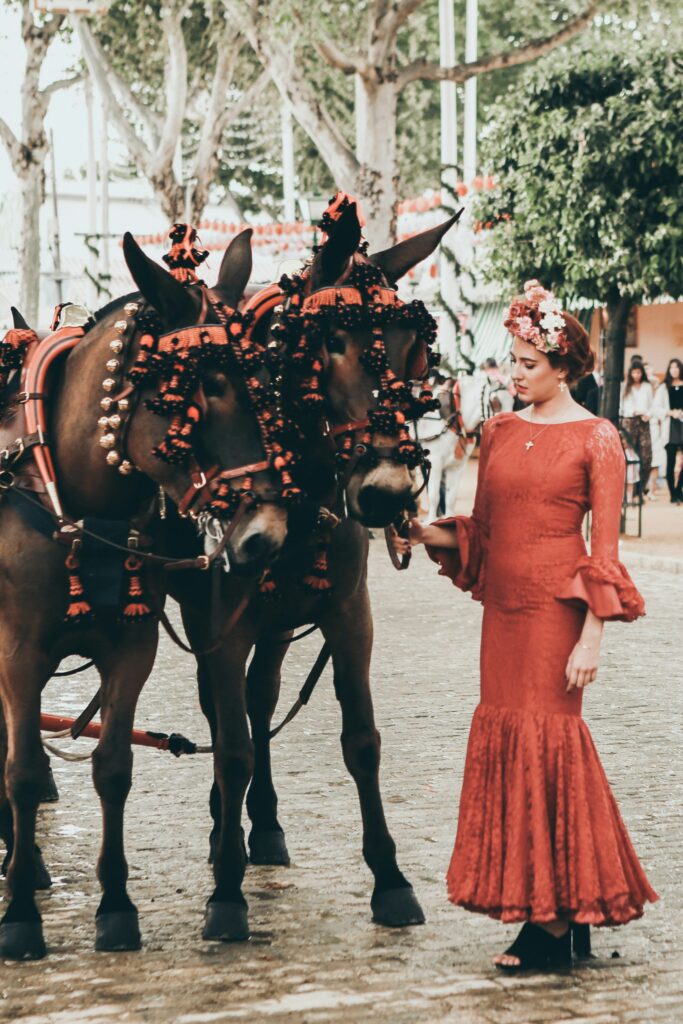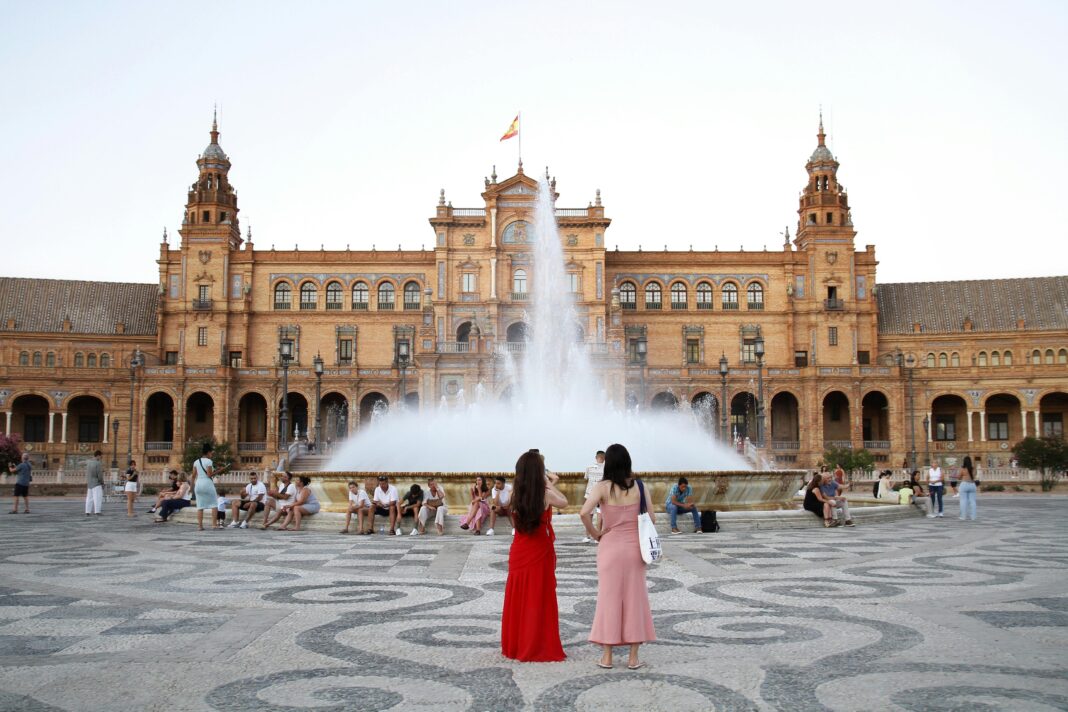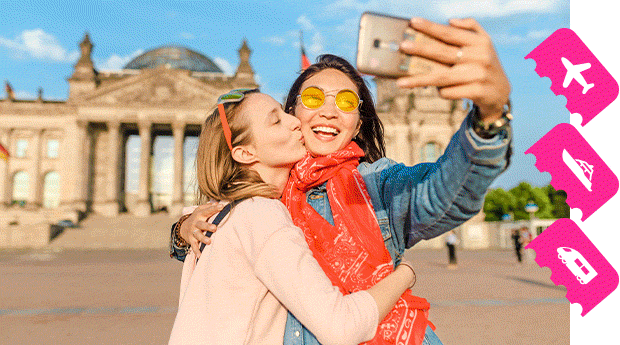Queer pilgrimages to Spain often morph into an endless parade of beaches. Southern Spain is no different: Gays flock to the sweltering sands of Torremolinos like it’s a freshly opened bottle of poppers.
However, culturally inclined queers would be missing something if they made a beeline for the nearest Speedo Central without spending time in Seville, the cultural capital of Andalusia. With its splendid mix of Roman, Islamic, baroque and Catholic influences, Seville rewards curious travellers with open arms. It may not have a coastline, but as Spain’s fourth-largest city, with a metro population of about 1.5 million, it has a rich history and style to spare—not to mention great tapas.

Spain already shines as one of the most queer-friendly countries in the world. Queer Spaniards can marry, adopt, serve in the military, donate blood, officially change gender… The list goes on. In 2025, the country celebrates the 20th anniversary of legalizing same-gender marriage, the world’s third country to do so. Spain has also so far bucked the scary far-right trend that has recently infiltrated many other European countries. Young and progressive Europeans frequently discuss leaving the U.K., Italy, France and Germany to live within Spain’s inclusive borders.
Even within Spain, Seville stands out as a queer haven. Sevillanos are famously gregarious, loquacious and generous with their time. This openness extends to outsiders, including those of the queer variety. In Seville, LGBTQ+ visitors will find a city deeply rooted in community and pride, and sevillanos will quickly make them feel like one of their own. Oh, and Seville is also a great place to watch or try flamenco—and what gay doesn’t love dramatic choreographed dances in beautiful gowns?
The feast of art and architecture reached lavish heights during Seville’s Golden Age, in the 16th and 17th centuries, the era the baroque masters Murillo and Velázquez made their mark on the city. Their work can still be found at El Hospital de los Venerables (Pl. Venerables, 3, Casco Antiguo, Seville) and El Museo de Bellas Artes (Pl. del Museo, 9, Casco Antiguo, Seville). Add in treasures by El Greco and Goya, and the sublime Mudejar-style carvings of El Real Alcázar (as seen on Game of Thrones), and you have yourself an aesthete’s dream. It’s not all hundreds of years old. After hosting the Expo ’92, the city got a taste for eye-catching modern architecture. Seville is built for long walks and awestruck silences.
Speaking of long walks, a visitor might begin theirs in Barrio Santa Cruz, Seville’s historical centre. Meander through the tangled cobblestone lanes to find plazas lined with orange trees and some of the city’s most iconic buildings. Meanwhile, Barrio Soho Benita offers shopping galore near Las Setas, Seville’s futuristic wooden mushroom-shaped towers, which are Instagram famous.
Then cross the Guadalquivir River to find the district of Triana, once the point of departure for some Spanish explorers searching for the “New World.” A former hangout for sailors and Romani people, Triana is now a gritty-chic sanctuary for artists, alternative queers and adventurous tapas lovers (fried quail and snails on toast, anyone?). Triana might be a great place to find a starving queer artist to, let’s say, “invest” in.
For LGBTQ+ hotspots, however, La Alameda de Hércules is where visitors will want to go. Framed on either side by ancient Roman columns, Alameda offers nightlife galore, with its laid-back bars and thumping late-night clubs—though some of the cooler haunts have migrated to nearby Calle Feria. Start your night slow with vermouth or sangria in a shady plaza before hitting the clubs and seeing how things pan out.
Of course, fuel is required to keep up with the late-night shenanigans—visitors should immerse themselves in Seville’s vast tapas culture. Lunch happens in a flash, from roughly 1 p.m. to 3 p.m. with few exceptions, whereas dinner doesn’t begin until at least 8 p.m. In the meantime, especially in the summer, Sevillanos refresh, regroup and dream about what they’ll eat during Tapas Round Two. Local favourites include solomillo al whisky (pork in whisky sauce), salmorejo (a creamy tomato-garlic soup topped with ham and egg), and classics like jamón ibérico and bull’s tail croquettes.
Spring is an ideal time to visit for those who hate the heat. The orange trees are in bloom and the temperatures hover between 15 and 21 degrees Celsius. The festival of La Feria de Abril is a week packed with ruffled dresses, castanets and contagious joy. Or party at Pride—Orgullo de Andalucía, southern Spain’s largest Pride celebration, which takes place in late June (2026 TBA). During summer in Seville, take advantage of the city’s shady streets and gazpacho outposts—and hydrate, hydrate, hydrate. Summer hotel deals are possible since fewer people visit during this time.

Often considered the most pijo (posh) of Andalusian cities, Seville is packed with people who dress better, walk taller and maintain pride in their polished urbanity. Visitors also fall in love with the way the sunlight hits Seville’s burnt orange buildings during golden hour. Here is our insider’s guide to the best of LGBTQ+ Seville.
Pride
Orgullo de Andalucía (late June; 2026 TBA). Though it’s not in the same league as Madrid (who is?), Seville’s Pride is the largest in southern Spain and brings out Spaniards and visitors in droves for the parade, cultural programming and street party.
What to see and do
Real Alcázar (Casco Antiguo, Seville). This group of palaces started life as a Muslim fortress in the 11th century but became much more grand after the re-conquest—the efforts by Christian kingdoms to reclaim the Iberian peninsula from Muslim rule. In the 14th century, King Pedro added the Palacio de Don Pedro, which is the crowning achievement of the complex. It’s the oldest royal palace in Europe still in use today. Marvel at bougainvillea-packed gardens, mesmerizing tile patterns and regal architecture that you might have already seen in the Dorne storylines of Game of Thrones. Buy morning tickets in advance to avoid the crowd.
Catedral de Sevilla (Av. de la Constitución s/n, Casco Antiguo, Seville). The world’s largest Gothic cathedral, completed in the 16th century, is designed to leave you speechless. Check out Christopher Columbus’s tomb and climb La Giralda for stunning views of the city. Make sure to buy tickets in advance.
Plaza de España (Av. Isabel la Católica, Seville). This grand brick-and-tile plaza is bombastic, flamboyant and bold—everything queers love. Rent a boat and float down the canals or simply behold the intricate series of tile panels lining the walls.
Casa de La Memoria (C. Cuna 6, Casco Antiguo, Seville). Catch an early show at this museum, cultural centre and performance space dedicated to flamenco and feel your jaw drop at the intricate footwork on display.
Las Setas (Pl. de la Encarnación s/n, Casco Antiguo, Seville). Designed by German architect Jürgen Mayer, Las Setas (“the mushrooms”) was completed in 2011 as part of a project to revitalize the Plaza de la Encarnación. It’s the largest wooden structure in the world. Buy a ticket to the top for views of the city, then visit the aquarium or architectural centre before shopping at the chic local boutiques.
Centro Andaluz de Arte Contemporáneo (Avda. Américo Vespucio 2, Seville). Housed in the Monasterio de Santa María de Las Cuevas, this museum features Spanish and international contemporary art in permanent and special exhibitions.
Where to stay
Halo Boutique Hotel Sevilla (C. Gloria, 3, Casco Antiguo, Seville). Conveniently located near the city’s main attractions, this adults-only haven in a converted 19th-century building packs in a lot of value. Some rooms have terraces. If you fail to snag one, there’s a separate rooftop terrace with city views.
The Nomad Hostel (C. Itálica, 1, Casco Antiguo, Seville). This queer-friendly budget accommodation has private and dorm rooms just a 10-minute walk from the cathedral. The cheerful communal areas make it a social experience for those who want to meet fellow travellers.
Patio de La Alameda (Plaza, Alameda de Hércules 31, Seville). This converted 19th-century palace is right in the middle of Seville’s gaybourhood. Most of the rooms are off a peaceful, flower-filled courtyard, and it has a lovely rooftop terrace. The hotel also has centrally located apartments for rent.
Soho Boutique Sevilla (C. Javier Lasso de la Vega 6, Casco Antiguo, Seville). This mid-budget queer-friendly spot is close to major historical attractions, but with the added benefit of being in a former mansion. There are posh touches everywhere. Outdoor pool and pet friendly.
H10 Casa de la Plata (C. Lagar 2, Casco Antiguo, Seville). This “Silver House” is a mid-budget Alameda boutique with a rooftop terrace. It comes highly rated for its excellent service, verdant courtyard and tiled décor.
Banana Gay House (C. Rosario 9, Casco Antiguo, Seville). This men-only eight-room guesthouse has been catering to a gay clientele for more than a decade. The clothing-optional terrace is a perk, as is the naked massage service. No, the hot men in the promotional photos do not come with the rooms. Day passes are available.
Where to eat
La Casa del Tigre (C. Amparo 9, Local B, Casco Antiguo, Seville). This upscale tapas bar has great mini buttered brioches topped with smoked salmon and lime gel. Make sure to get a reservation.
Lama La Uva (C. Regina 1, Local 4, Casco Antiguo, Seville). Seville oranges don’t make for good snacks (too bitter), but they make great wine. Lama La Uva, which has the retro feeling of an old-time-y dry goods store, is the place to try it.
Casa Ruperto (Av. Santa Cecilia 2, Seville). This Triana tapas bar is famous among locals for its fried quail, which tastes better than it looks.
La Gata en Bicicleta (C. Pérez Galdós 22, Casco Antiguo, Seville). This queer Alameda café doubles as a bookstore. It’s a great place to grab an espresso and a snack.
Bar El Comercio (C. Lineros 9, Casco Antiguo, Seville). With a history going back to 1904, this snack bar is close to Alameda nightlife. They serve incredible churros.
Where to party
El Bosque Animado (C. Arias Montano 5, Casco Antiguo, Seville). El Bosque Animado (“The Enchanted Forest”) has an eclectic, vaguely sylvan décor. It’s a friendly little bar that makes for a great place to start the night.
Mentiroso Café-Bar (Calle Compañía 1, Casco Antiguo, Seville). Not a bad choice for those looking for an intimate, quiet place to sip a cool cocktail before the night heats up.
Dilema (Alameda de Hércules 80, Casco Antiguo, Seville). Heavy on locals yet friendly toward foreigners, this fun little hole in the wall, decorated with assorted memorabilia, meshes a convivial atmosphere with refreshing cocktails.
PRIDE B4R (Formerly Men2Men, Calle Trajano 38, entrada por Delgado 1, Seville). The kitschy laid-back PRIDE B4R has two floors. The clientele is mixed, leaning into bears. Good drinks and solid drag shows.
ITACA (C. Amor de Dios 31, Casco Antiguo, Seville). A veteran Seville venue, ITACA straddles the line between seedy, smoky cruising bar and traditional dance club. It gets packed on Saturdays and has a fun darkroom. They host the popular pop-driven night SissyPop every Friday.
1987 Bar (Alameda de Hércules 93, Casco Antiguo, Seville). As the name implies, this is an excellent place to time travel back to a few decades. Let the ’80s hits and neon memorabilia sweep you away.
Alameda Ritual Club (Alameda de Hércules 68, Casco Antiguo, Seville). The small but mighty Alameda Ritual Club boasts warm staff, a bustling terrace, bisexual lighting and a crowd that appreciates bending gender.
Where gay and bi guys can find fun
Sauna Termas Hispalis (C. Céfiro 3, Seville). With dry and wet saunas, a giant hot tub and lots of cruising areas, this is a dependable gay bathhouse with a mixed clientele. A bit outside of the city centre. Various discounts and themes depending on the night.
Sauna the Cube Urban (C. Perafán de Rivera 8, Seville). Rife with dark, hairy men and numerous dark rooms to enjoy them in, this sauna truly has no shortage of surprises. It’s divided into three zones with different décor and music in each one.
El Bunker (Bar el Bunker, C. Torrijiano, 2, Seville). This men-only cruising bar is dedicated to debauchery and has been known to host Naked Nights.
The Boyz Sevilla (C. Doña María Coronel 34, Casco Antiguo, Seville). This men’s cruising bar hosts shirtless nights, underwear nights, naked nights and the occasional live sex show.
Where to shop
La Importadora (C. Pérez Galdós 2, Casco Antiguo, Seville). Part hip art gallery, part vintage clothing store, this airy boutique has something for everyone.
PuroEGO El Corte Inglés Duque de la Victoria (S1 El Corte Inglés Duque, Pl. del Duque de la Victoria 8, Casco Antiguo, Seville). Within the men’s department of the popular national department store El Corte Inglés is the PureEGO collection, a trendy take on streetwear.
Berwick 1707 (Pl. de la Magdalena 5, Casco Antiguo, Seville). There aren’t many specialty men’s stores in Seville, but if you’re on the market for some truly well-crafted shoes, Berwick 1707 fits the bill.
Queens Boutique (C. Puente y Pellón 4, Casco Antiguo, Seville). Fancy a little Flamenco fashion? This LGBTQ+-friendly clothing shop will get you into the most dramatic outfit possible.
Calle Sierpes. This long, narrow, pedestrianized street is Seville’s most famous shopping area, with national and international fashion brands.


